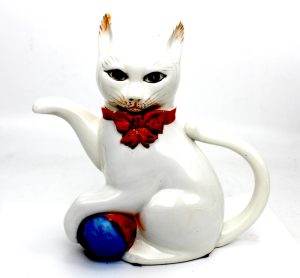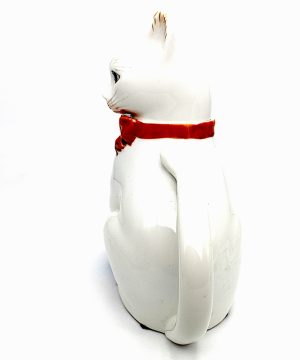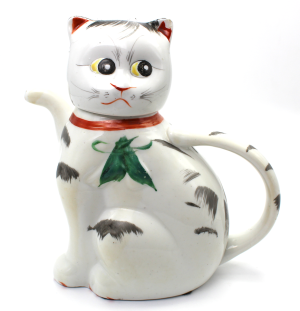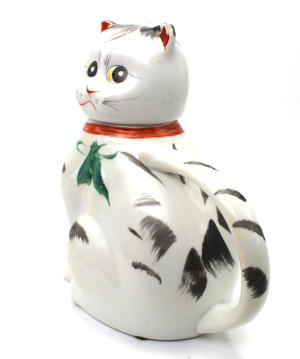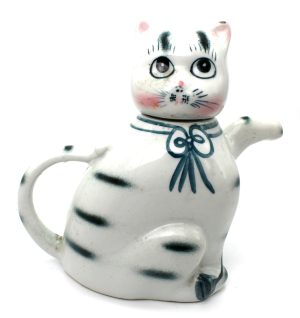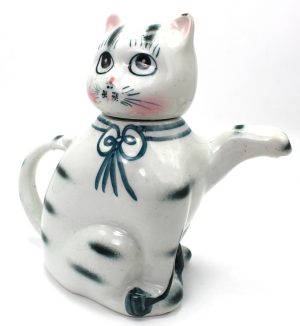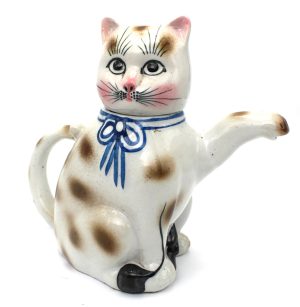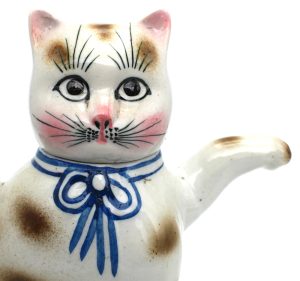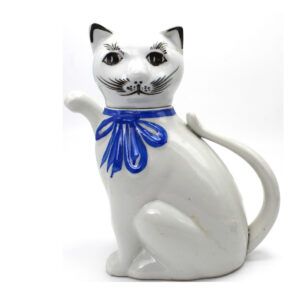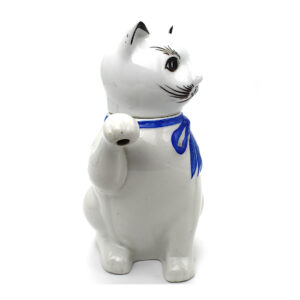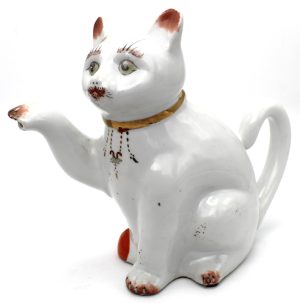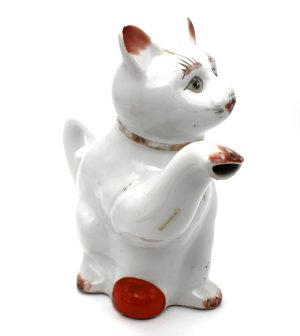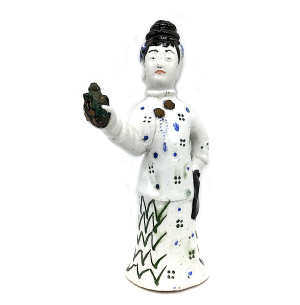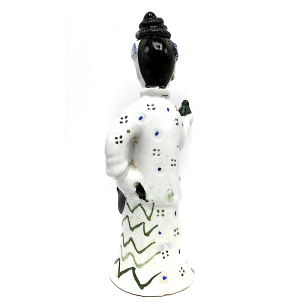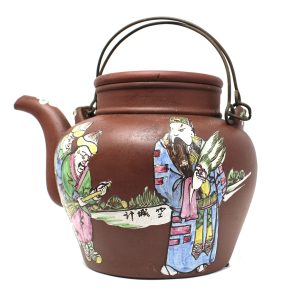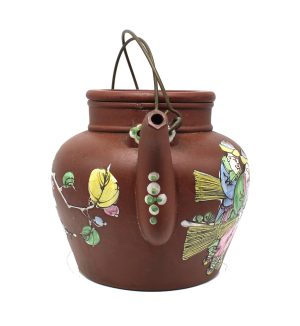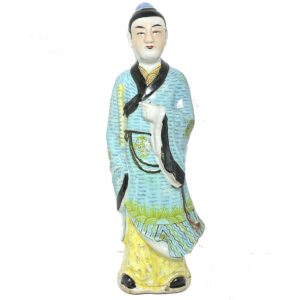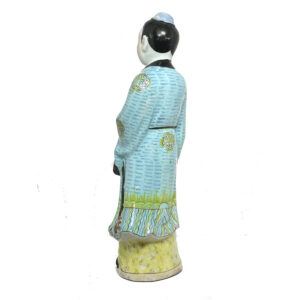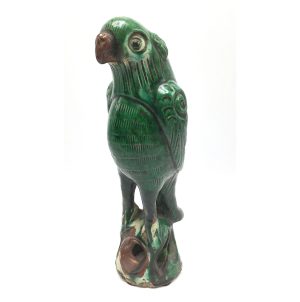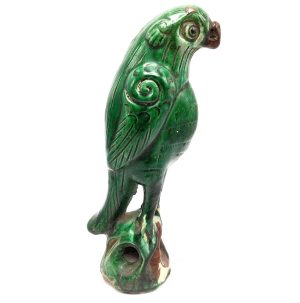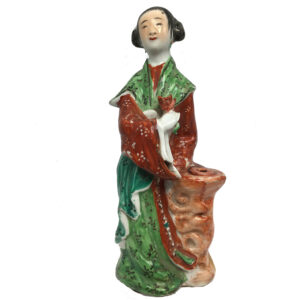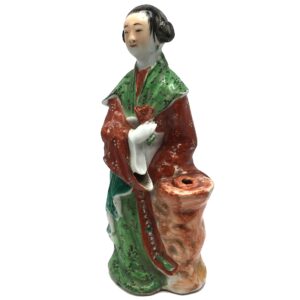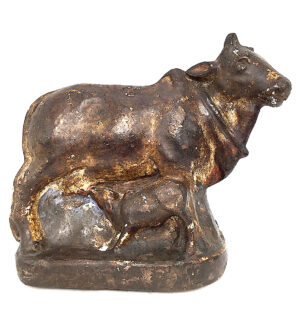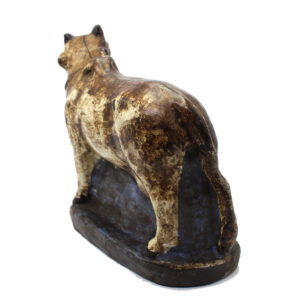Showing 13–24 of 27 results
-


$135.00
H: 8” W: 8” D: 3.75” | FREE SHIPPING IN CONTINENTAL US!
This charming white porcelain Siamese cat teapot has a raised paw for pouring tea, a removable head for adding water , and a long sinuous tail handle. The beautifully hand-painted design is whimsical and colorful with a thick dark red collar ribbon, a matching ornamental bow, and a ball under its left paw. Black, orange, red and blue accents define the cat’s face, ears, head, paws and the ball.
-


$145.00
H: 8” W: 8” D: 3.75” | FREE SHIPPING WITHIN CONTINENTAL U.S.!
This charming vintage porcelain cat teapot with raised paw for pouring tea, removable head and a sinuous tail handle is whimsical and colorful with a red ribbon collar, green bow and green, black and red accents defining the expressive face, ears, head and paws, all beautifully hand-painted.
-


$135.00
H: 7” W: 8” D: 3.625” | FREE SHIPPING WITHIN CONTINENTAL U.S.!
This porcelain teapot is a rotund cat figurine comically sitting on a mouse. It has a raised paw spout, a removable head and a long sinuous tail handle. The whimsical and colorful design with long ribbon and blue collar with a dangling blue bow and the black, pink, and brown accents that define the face, ears, head, paws and body and all are hand painted.
-


$135.00
H: 7” W: 8” D: 3.625” | FREE SHIPPING WITHIN CONTINENTAL U.S.!
This porcelain teapot is a rotund cat figurine comically sitting on a mouse. It has a raised paw spout, a removable head and a long sinuous tail handle. The whimsical and colorful design with long ribbon and blue collar with a dangling blue bow and the black, pink, and brown accents that define the face, ears, head, paws and body and all are hand painted.
-


$130.00
H: 8” W: 8” D: 3.75” | FREE SHIPPING WITHIN CONTINENTAL U.S.!
This charming vintage porcelain cat teapot with raised paw for pouring tea, removable head and a sinuous tail handle is whimsical and colorful with a red ribbon collar, green bow and green, black and red accents defining the expressive face, ears, head and paws, all beautifully hand-painted.
-


$130.00
Ht: 8” W: 8” D: 3.75” FREE SHIPPING WITHIN CONTINENTAL U.S.!
This large, charming Republic seated cat teapot has a raised paw and a removable head to allow hot water to be poured inside through the neck and a long, a sinuously curved cat tail handle that allows one to pour liquid out the hole at the end of the paw. Whimsically painted with a decorative collar it represents a gesture of greeting and hospitality it is believed to welcome good luck and fortune.
-


$265.00
Ht: 8.5” W: 5” D: 3” | FREE SHIPPING WITHIN CONTINENTAL U.S.!
This small charming Qing or early Chinese Republic teapot is in the form of an attendant, the arm she holds up imitates the spout of a teapot, the left arm arches to touch her waist suggesting a teapot handle and the hair is atop her head with flowers is a removable lid for pouring tea inside. She typical attendant clothing, a high mandarin collared jacket draped over a flaring skirt that is the piece’s base.
-
Sale!


$975.00 Original price was: $975.00.$695.00Current price is: $695.00.
H: 6” W: 8.5” D: 6.125” | FREE SHIPPING IN CONTINENTAL U.S.!
Yixing stoneware teapots are praised as the best in the world for tea infusion. This gorgeous, extremely rare antique teapot with tight-fitting lid and elegant spout is finely decorated with a brown wash and hand applied bright painted enamel designs designs of a scene from the Peking opera Romance of Three Kingdoms. The floral images are a wish for a long and healthy life, perfect metaphors for those sharing a fresh pot of tea with those they love. Kiln seals are impressed in the body, bottom and lid.
-


$295.00
H: 12” W: 4.5” D: 3” | FREE SHIPPING WITHIN CONTINENTAL U.S.
This elegant Chinese Republic Period porcelain is the Taoist immortal Han Xiangzi carrying his auspicious flute dressed in a beautiful blue robe with wide black borders, fine internal decorations and a decorative yellow floral undergarment. On the bottom is the kiln seal. As the patron saint of musicians and florists, it is a great gift for someone who enjoys these pursuits.
-


$295.00
SOLD H: 9″ W: 3 ” D: 3.5 ” | FREE SHIPPING!
Chinese Republic ceramic parrots are commonly depiction as this one perched on an open rocky base. Porcelain parrots were produced for the domestic and export markets and sometimes sold in pairs leading some to believe they, like pairs of fish, symbolized the love and fidelity of married couples. This one has vivid polychrome colors, large eyes and stylized wings. This piece is in excellent condition.
-


$240.00
Ht: 9.75″ W: 3.5″ D: 2.5″ | FREE SHIPPING WITHIN CONTINENTAL U.S. !
This Chinese Republic Period delicate porcelain figurine holds a rose at her heart in her right snow white hand, her left arm covered by her shawl resting on a waist-high decorative vase with an opening to hold incense (joss) sticks. Her shawl drapes over her shoulders and lower garment with floral motifs extending to the beaded belt at her waist. The sweet facial expression with slightly smiling bowed lips is framed by her piled hair looped in a chignon over each ear. Given her luxurious garments and accessories, she is an aristocratic woman. The rose was often used on porcelains during this period, representing eternal spring.
-
Sale!


$105.00 Original price was: $105.00.$85.00Current price is: $85.00.
H: 7″ W:8.25″ D: 3.125″ | FREE SHIPPING WITHIN CONTINENTAL U.S.!
Vintage bivalve mold figures like this cow were hand luted and hand painted, in the likeness of Hindu religious figures, soldiers, animals are used in rural India where they are seen as wishes for a better life.
End of content
End of content

